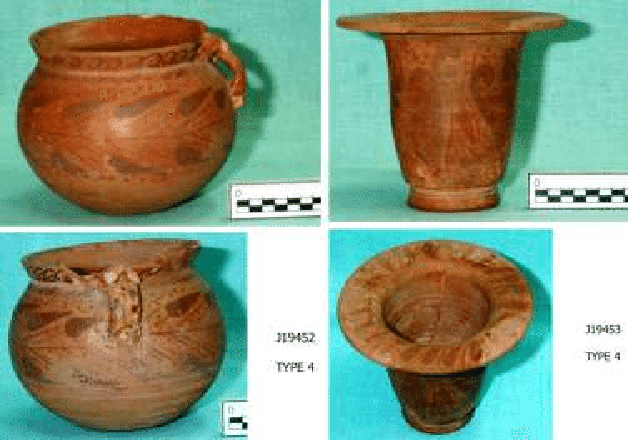You are here
Study shows Wadi ath-Thamad clays suitable for Nabataean pottery production
By Saeb Rawashdeh - Apr 17,2025 - Last updated at Apr 17,2025

Photo courtesy of Jordan Archaeological Museum (Nabataean painted fine vessels)
AMMAN — Scholars have no evidence of a pottery workshop at the Nabataean settlement of Mudayna Thamad, although they found many pottery pieces at the site.
The easy access to clay resources in the Wadi ath-Thamad for local pottery making at Mudayna Thamad prompted a multidisciplinary study to investigate attributes of the wadi clay and its suitability for manufacturing small bowls.
"We began with an experimental archaeology project where a professional potter easily threw several small bowls from a hump of wadi clay, which fired successfully," said Maria-Louise Sidoroff, an independent scholar.
Sidoroff added that based on the experimental results, an investigation of resources in the Wadi ath-Thamad collected by Braun and her was undertaken.
This included plasticity tests and firings conducted on two sets of samples from the wadi for information about the clay attributes.
Three of the Braun samples were taken from recent naturally levigated alluvial deposits and all Sidoroff samples were taken from recent alluvial deposits based on evidence from successful replication experiments with naturally levigated clay and the earlier experiments with wadi clay.
"A preliminary test in the field with a moistened claycoil twisted into a ring was used as a guide to sample choice. The size of particles of clay grains gives an indication of the property of plasticity in are source because the smallest sizes give the greatest plasticity, which is important especially for wheel throwing,” the scholar said.
“In a small clear container with a tight lid, 40 ml water was added and 10 ml clay. The container was shaken until the clay particles were in complete suspension, then it was left unmoved while observations were recorded every ten minutes for 2 hours," Sidoroff elaborated.
According to geochemist Velde, the lightest and smallest clay grains settle more slowly. As clays are the smallest materials with regard to grain size they tend to stay afloat longer and can be separated from the larger grains. If the water still remains cloudy after 2 hours this indicates good potting clay. Several clay samples remained in suspension for 2 hours.
The test results indicated there are deposits of alluvial clays in the Wadi ath-Thamad with sufficient plasticity.
"Tests of the Braun samples were formed into eight round clay tokens [3 cm diameter, 5 mm thickness] that were fired to cone 06 [1028°C] in the electric kiln of an art pottery studio. The second group of Sidoroff clay samples were formed into twelve rectangular shaped tiles [5 cm x 83 cm x 6 mm thickness]," Sidoroff noted.
She added that due to and fired by Dr. Ann Cordell the abundance of calcium carbonate in Wadi ath-Thamad clay and fired colour of some bowls as mentioned above, it was hypothesised that some Nabataean unpainted bowls may have been fired at a low temperature in antiquity since there was rare evidence of calcium carbonate spalling on Nabataean ware from the Mudayna Thamad settlement.
There is an ongoing dialogue regarding firing temperatures for calcareous clays before the calcium decomposes and forms lime. When calcareous clays are fired between 650°C and 900°C lime is formed, which leads to cracks in vessel walls, called spalling, as the lime absorbs atmospheric moisture after firing.
Firing test tiles at the lowest temperature would avoid this effect and would more closely replicate heat in open pit firings using fuel such as brush or dung, and leave few traces of this activity.
Based on this information, a different firing regime was conducted for the Sidoroff clay test tiles.
Dr. Cordell began the controlled firing sequence at 3:55 pm when the electric kiln was and then maintained at 275°C for ten minutes (with the door cracked), then the door was shut completely and the temperature was raised to 650°C over a period of twenty minutes.
The 650°C temperature was maintained for thirty minutes. The kiln was turned off at 5:10 pm and opened slightly to begin cooling. The entire firing process (when the furnace was on) took 75 minutes, Sidoroff explained.
Based on this firing, the results indicated that the Wadi ath-Thamad clay samples can achieve hardness at low temperatures resulting in more subdued colours than the fired colours of Nabataean ware from Petra.
"Nevertheless, the experiments showed that plastic clays were available near Mudayna Thamad that could be used to produce fine ware bowls with reddish yellow colours," Sidoroff concluded.














